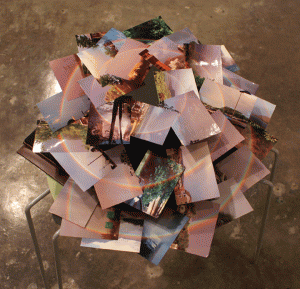« Reviews
The Importance of Daydreams
Curated by Tyler Emerson-Dorsch
World Class Boxing – Wynwood Art District, Miami
July 11 – August 31, 2009
The Challenges of Daydreaming
By Irina Leyva-Pérez
Putting together a collective exhibition is never an easy task. Finding the connection between the works and presenting them is always a challenge. If that exercise has to be done by selecting the pieces from a private collection, then it gets more complicated. This is precisely what curator Tyler Emerson-Dorsch did with “The Importance of Daydreams,” taking the works from the Debra and Dennis Scholl art collection. Her advantage was that she had at her fingertips pieces by very important artists. The nature of this collection obviously determined the type of exhibition. Daydream is a compilation of cutting-edge art pieces. Of the thirteen pieces, five are videos and one is a sound installation, a clear indication of the contemporary trend. On this occasion, she brought together works by Edgar Arceneaux, Chris Sauter, John Baldessari, Eija-Liisa Ahtila, Tim Davis, Bruce Conner, Paul Chan, Peter Coffin, Meredyth Sparks, Natalia Benedetti, Jack Strange, Charles & Ray Eames and Mitzi Pederson. An eclectic mix one might think; nevertheless, the curator found a way to interconnect it all.
The initial idea was to bring together works that could offer an idea of the process of art collecting as the Scholls see it. What could motivate them to buy a particular piece? What is the balance between their rational thoughts as business people and their passion as art collectors? Where do both meet? Is collecting art their daydream escape? Looking through the exhibition, we can see what makes them bring each artwork into their collection.
For example: John Baldessari’s The Fallen Easel (1988). It corresponds to his characteristic works: the cerebral statements and his intentional desire to mess with his public. We can go through his works exhaustively trying to figure out exactly why he placed something where he did. If he were looking at us during this exercise, he would probably laugh his head off, happy that he got what he wanted: to show us the absurdity that often plagues the contemporary art world.
Another intriguing piece is Chris Sauter’s video, Empire (2006), which lasts eight hours. It is a seemingly motionless image where only the American flag moves sometimes. He based the whole piece on an image of an iconic building in his hometown. Were we not familiar with the context and the circumstances of the place, the whole message would be easily missed: we would not get his remarks about the nature of the building and its association with social commentary.
Perhaps the most touching work is Hour of Prayer (2005), by Eija-Liisa Ahtila. This was part of a video installation, but the Scholls only acquired the sound part. The artist relates her life with her dog, Lucaboy, and how he died. Based on the storytelling tradition, Eija-Liisa managed to give us just the elements needed for us to imagine the whole story actually happening in front of us. According to the artist, this is her only piece that is actually based on autobiographical experiences.
This is indeed a tricky exhibition; it was at first for the curator and it is now for the spectators, who walk through it trying to understand the diversity of the works and what is behind each of them. This is a slice of the Scholl’s collection, demonstrating the complexity of it and the trains of thought behind it.
Irina Leyva-Pérez: BA in Art History (University of Havana, Cuba). Former Assistant Curator at the National Gallery of Jamaica. Currently Curator of Pan American Art Projects. She resides in Miami, FL.
Filed Under: Reviews



































